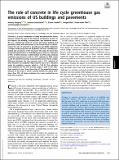| dc.contributor.author | Gregory, Jeremy | |
| dc.contributor.author | AzariJafari, Hessam | |
| dc.contributor.author | Vahidi, Ehsan | |
| dc.contributor.author | Guo, Fengdi | |
| dc.contributor.author | Ulm, Franz-Josef | |
| dc.contributor.author | Kirchain, Randolph | |
| dc.date.accessioned | 2021-10-25T18:16:21Z | |
| dc.date.available | 2021-10-25T18:16:21Z | |
| dc.date.issued | 2021-09 | |
| dc.date.submitted | 2020-10 | |
| dc.identifier.issn | 1091-6490 | |
| dc.identifier.uri | https://hdl.handle.net/1721.1/133100 | |
| dc.description.abstract | <jats:p>Concrete is a critical component of deep decarbonization efforts because of both the scale of the industry and because of how its use impacts the building, transportation, and industrial sectors. We use a bottom-up model of current and future building and pavement stocks and construction in the United States to contextualize the role of concrete in greenhouse gas (GHG) reductions strategies under projected and ambitious scenarios, including embodied and use phases of the structures’ life cycle. We show that projected improvements in the building sector result in a reduction of 49% of GHG emissions in 2050 relative to 2016 levels, whereas ambitious improvements result in a 57% reduction in 2050, which is 22.5 Gt cumulative saving. The pavements sector shows a larger difference between the two scenarios with a 14% reduction of GHG emissions for projected improvements and a 65% reduction under the ambitious scenario, which is ∼1.35 Gt. This reduction occurs despite the fact that concrete usage in 2050 in the ambitious scenario is over three times that of the projected scenario because of the ways in which concrete lowers use phase emissions. Over 70% of future emissions from new construction are from the use phase.</jats:p> | en_US |
| dc.language.iso | en | |
| dc.publisher | Proceedings of the National Academy of Sciences | en_US |
| dc.relation.isversionof | 10.1073/pnas.2021936118 | en_US |
| dc.rights | Article is made available in accordance with the publisher's policy and may be subject to US copyright law. Please refer to the publisher's site for terms of use. | en_US |
| dc.source | PNAS | en_US |
| dc.title | The role of concrete in life cycle greenhouse gas emissions of US buildings and pavements | en_US |
| dc.type | Article | en_US |
| dc.identifier.citation | Jeremy Gregory, Hessam AzariJafari, Ehsan Vahidi, Fengdi Guo, Franz-Josef Ulm, Randolph Kirchain, The role of concrete in life cycle greenhouse gas emissions of US buildings and pavements, Proceedings of the National Academy of Sciences Sep 2021, 118 (37) | en_US |
| dc.contributor.department | Massachusetts Institute of Technology. Department of Civil and Environmental Engineering | |
| dc.contributor.department | MIT Materials Research Laboratory | |
| dc.relation.journal | Proceedings of the National Academy of Sciences | en_US |
| dc.eprint.version | Final published version | en_US |
| dc.type.uri | http://purl.org/eprint/type/JournalArticle | en_US |
| eprint.status | http://purl.org/eprint/status/PeerReviewed | en_US |
| dc.date.updated | 2021-10-21T18:10:01Z | |
| dspace.orderedauthors | Gregory, J; AzariJafari, H; Vahidi, E; Guo, F; Ulm, F-J; Kirchain, R | en_US |
| dspace.date.submission | 2021-10-21T18:10:03Z | |
| mit.journal.volume | 118 | en_US |
| mit.journal.issue | 37 | en_US |
| mit.license | PUBLISHER_POLICY | |
| mit.metadata.status | Authority Work Needed | en_US |
